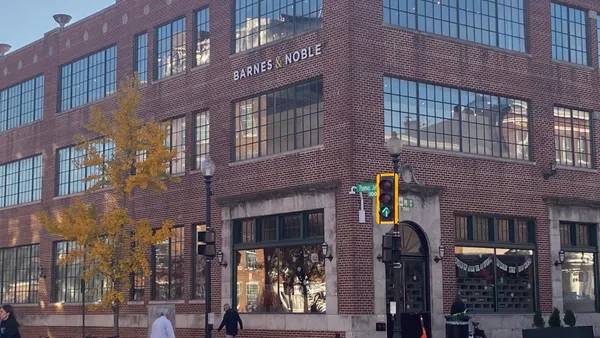Dive Brief:
- As e-commerce expands at a blazing clip, Amazon is on track to pass Walmart as the largest U.S. retailer by 2025, according to Retail Insight, the research arm of Edge by Ascential.
- The firm predicts Amazon's gross merchandise value sales, buoyed by its third-party marketplace, will hit $631.6 billion in four years as total online sales in the U.S. hit an estimated $1 trillion by 2025, Edge by Ascential said in a press release.
- During that time, the firm estimates Walmart's domestic sales will grow at an annual rate of 3.9%, hitting $523.3 billion by 2025.
Dive Insight:
While Amazon's growth hit an explosive pace throughout the past decade, you could be forgiven for forgetting the elephant in the room, one that for years has sat at the top of Fortune's list of largest companies in the world by revenue.
A couple years of declining sales growth were enough to wake Walmart up to the immediate threat of its online rival. After a stint of sales declines, Walmart made a blockbuster e-commerce acquisition of Jet.com. Jet eventually faded away under Walmart, but its founder, Marc Lore, took over Walmart e-commerce operations.
Under Lore, who announced his retirement from the company this year, e-commerce growth expanded regularly by double digits and accelerated even more during the pandemic. Edge by Ascential estimates Walmart to keep up a strong pace of e-commerce growth, at an estimated nearly 15% a year to reach $87.5 billion in 2025. Which is a lot, to be sure, but not enough to stave Amazon's ascendancy, should the firm's estimates hold true.
The pandemic made Amazon as relevant a player as ever. Edge by Ascential estimates that e-commerce sales across the U.S. grew by 30% last year as many consumers avoided shopping in stores. For the same year, Amazon posted North American sales growth of 38.4%, reaching $236.3 billion.
The majority of those sales weren't executed by Amazon but rather the company's massive base of independent retailers and brands that sell through Amazon's Marketplace platform. Edge by Ascential estimates that third-party sellers will account for 66% of Amazon's gross merchandise value by 2025, up from 60% in 2020.
The sheer size of Amazon's marketplace has made it a relevant force to nearly every brand, even those that opt not to sell on it. Amazon's platform has also given rise to a smorgasbord of independent brands that have grown up on Amazon, and which some well-financed acquirers see as major players in the future of the consumer products landscape.
"As Amazon grows to become the largest retailer in the US, brands must understand they cannot win through mass personalization when faced with the huge spending power of large marketplaces like this," Deren Baker, CEO of Edge by Ascential, said in the release. "They should therefore ensure they have the correct strategies in place to use marketplaces, like Amazon, to reach the right consumers and meet their needs."
To be sure, Walmart would still be huge even if Edge by Essential's scenario holds. The retailer has an advantage in its massive store base — where it is still much larger than Amazon and has been handily out-competing the e-commerce native. (In Q1 of this year, Amazon's physical store sales were down 16%.)
Even amid the pandemic and surge in digital shopping, Walmart was able to lean on its stores as fulfillment centers. It is also looking to add more services to those stores, including health and financial, that could keep those physical spaces as relevant as ever.













